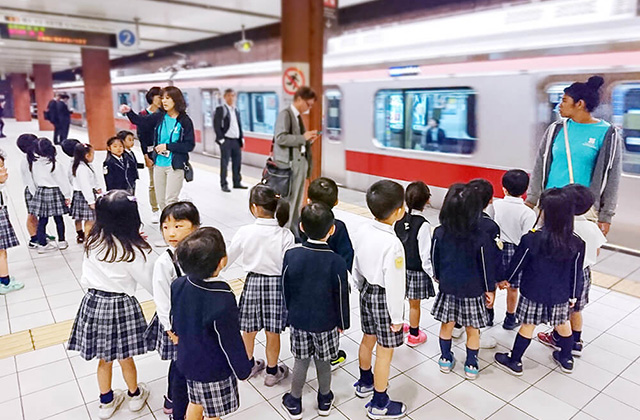Curriculum
Introduction to the Enrichment Program
CGK Preschool is currently an International Baccalaureate (IB) PYP World School, engaging in daily childcare and education through a transdisciplinary approach.
The contents below reflect the activities we conducted based on the curriculum we developed prior to the introduction of the IB. While some of the approaches do not align with our current IB-based transdisciplinary system of childcare and education, each lesson or activity that we conducted was part of our process for providing a well rounded curriculum that fosters a spirit of inquiry, critical thinking skills, and self-expression. Becoming an IB World School helped us refine our approach and add even more academic rigor, but built off of the foundation we had already established as a school. Therefore, we will continue to highlight our original approach and lessons on this page.
We will continue to provide updates on childcare and education that more closely reflect the IB curriculum on this page and in our blog in the future.
Talk Time
Students learn the words and phrases for the monthly theme and their usage. The words and phrases will be related to other lessons to make the learning process more connected. Through "Show & Tell", students develop presentation skills.
-
Show & Tell


Instead of a daily correspondence notebook, at CGK we use an app, the advantage over a paper notebook is that this allows us to send photos or videos and have an unlimited number of words. Sometimes photos and videos are sent almost every day to convey to parents the situation at school as clearly as possible, and since this is a communication tool, it’s nice when parents also use photos and videos to share the situation at home too.
In Show & Tell activities, the children are asked in advance to send photos or videos that they want to present via the app, and then present these in front of the class. With the teacher nearby for support, they stand in front of the class alone and explain the photos / videos, then they answer any questions the other children may have. This is also a way to develop public speaking skills. -
(Example) Mini Camping Experience


Since the theme of this month's “Talk Time” was "Camping," we asked the owner of a camping-themed cafe near CGK to help us set up a tent and let us make s'mores, a popular camping snack. In this way, we try to introduce extracurricular activities in a flexible and proactive manner, not just studying in a classroom but actually experiencing things that will remain in the children's memory and generate further curiosity and spirit of inquiry.
<Instagram>TARPtoTARP
<YouTube>TARPtoTARPtoTV
Project-Based Learning(PBL)
At CGK, we emphasize active learning and have introduced PBL (Project-Based Learning) instead of the Japanese method of SBL (Subject-Based Learning). PBL is an active learning method based on problem-solving that encourages independent learning. To compare, SBL is a subject-based, progressive learning method. In SBL, it progresses sequentially from basics to application and learners cannot work with the goal in mind from the beginning, therefore, the path must be determined by an educator who knows the outcome. In PBL, larger themes or tasks are given, and the students take the initiative to work on it, make a hypothesis, conduct research and discussions, etc. It fosters independence, initiative, expressiveness, and the ability to think independently, something that Japanese people are often considered not good at. Since the projects are rather large, they take time to complete, but the students have a great sense of accomplishment and develop a stronger spirit of inquiry. Students communicate and cooperate with each other to solve problems, thereby nurturing critical thinking skills and a spirit of inquiry.
Job Training, described below, also involves many PBL-oriented projects.
(Example) Ice Cream Project
The ultimate goal of this project was for each group to build an "Ice Cream Store" and then present it at parent's observation day in a competition for first place.
Building an "Ice Cream Store" sounds like a lot of fun, but to start one up in real life, there's a lot of preparation involved.
- Create a logo for the store
- Discuss the store layout with functionality in mind
- Decide what flavors of ice cream to sell (Not your own favorite flavors, but conducting a survey to find out the favorite flavors of your customers)
- Decide how to decorate the ice cream
- Find out what ingredients are needed. Create recipes
- Purchase the necessary ingredients. Prepare the ice cream
- Give a presentation to highlight the features of your store
In fact, as each group worked towards their goal by inquiring of each other and doing the work together as a group, intervention by an educator was kept to a minimum. Students actually went shopping at the supermarket and prepared some food. At CGK, we value such hands-on experiences.
In the end, students had an opportunity to present their ideas and develop their presentation skills.
This was not simply a "fun" activity to pretend to make ice cream, rather, it was a big project that involved thinking carefully about what would be needed, what kind of decisions to make, what had to be done, etc. When the goal was finally achieved, the children gained a deep sense of accomplishment. Certainly, this kind of process helps students develop critical thinking skills and a spirit of inquiry.
Job Training
Students learn firsthand what workers in each profession do and how they contribute to society. While this program puts English to use in a practical way, the main purpose is to develop critical thinking skills and a spirit of inquiry. In many occupations, deep thinking and inquiry can help to gain new awareness. Actively incorporating extracurricular and group activities can nurture social skills and serve as a gateway to social experiences.
-
(Example) Pilot / Airport


Role playing an airport baggage inspection allowed the children to learn in an easy-to-understand yet fun way. First, after submitting their passports and receiving their tickets, the children moved on to the baggage inspection at the security checkpoint. In advance, the children were asked to choose one of their favorite items and put it in their bag for the inspection. If there was something prohibited in the bag, it was taken out and the children heard an explanation of why it was not allowed on the plane, which taught the children in a playful, fun way.
In a different lesson, we examined a map to anticipate what we would find at the airport and then actually went to Haneda Airport, this provided the children with an opportunity to experience the airport with a spirit of inquiry and exploration.<Blog>
2019年7月 Job Training "Pilot / Airport" ~ご出発の方は、お集まりください!~
2019年8月 羽田空港見学 ~Job Training "Pilot / Airport"~ -
(Example) Photographer


In the photographer, the children were explained how to take a photo, then we gave each child an instant camera that allowed them to actually take their own photos. However, the students didn't go around just taking any pictures they liked, but were encouraged to find themes and to check how many shots they had left, so they could select carefully how they would use their remaining photographs.
Of course, this was not just an indoor activity, but we enjoyed photo sessions while taking walks or going by bus to Yamashita Park and Nogeyama Zoo, etc.
After these sessions, we took the children to the photo shop to have their pictures developed and create photo albums. Then, they could take their precious memories home with them. -
(Example) City Planner


After discussing what their city would need and then distributing the workload amongst themselves, the whole class started on this activity. Although they brought leftover craft materials from home, the children were not given all the materials necessary for the work, this gave them opportunity to think about how they could be creative with the limited materials they had, and resulted in many unique, original buildings. Since this was an urban design project, it was not just about the students building whatever they liked.
What are the functions of a city and what is needed to achieve them?Where in the city should a building be located for its functionality and convenience (e.g., the airport should not be located in the city center because of safety and noise considerations, etc.)Finally, the mayor (a CGK teacher) toured the city. The children, who were asked a variety of questions, thoughtfully provided detailed explanations of the buildings they and their teams had built, making it clear that they had given careful thought to their creations. The mayor pointed out that "the lack of a station makes it inconvenient for people without cars to get around," which was a good reminder for the children.
By adjusting the timetable to focus on this activity only for a whole week, the children were able to concentrate without interruption. In the actual making of the city, they were able to develop self-expression and critical thinking skills by imagining what they wanted to make and how to make it. -
(Example) Postal Worker


Not only did students learn about the post office, the people who work there, letters and how to write them, but they also tried to make letters a part of life at CGK. We installed a mailbox in the classroom and a mailbox in each of the children's lockers (with each child assigned an address). Then, the children wrote letters and dropped them in the mailbox, and the letters were distributed to each address, much to the delight of those receiving letters! During the lesson, everyone learned how to write letters together, but the children enjoyed both writing and being written to so much, they continued writing even after the lesson was done. With many letters being exchanged daily, they really enjoyed writing naturally, not just writing as part of a class assignment.
Outdoors
CGK is located in the very center of Yokohama, just a 2-minute walk from Yokohama New City Hall. Although we have no school yard, we go out every day the weather permits and walk to various places. If the place to play changes, the play will also change, so the children enjoy all kinds of games in different environments while making discoveries every day, rather than playing in the same place.
Outdoor play at CGK is not limited to parks, but we go to shopping streets and post offices, take walks through the subway, visit construction sites, etc. We view these walks as opportunities for enrichment and education. In addition, we sometimes take the school bus to a different park, and we actively incorporate joint activities for different age groups.
Playing outside stimulates the five senses, fulfills emotional needs and activates the brain. At CGK, we consider outdoor play-time a very important activity, besides helping children to learn the rules of the road and social skills, moving around builds physical strength and a healthy body.
Swimming
Swimming lessons are provided by swimming coaches in a private indoor pool. This program is held 14 times a year (once or twice a month) to overcome fear of water and to learn the basics of swimming.
A Swimming Report Card is sent home every six months to update parents regarding their children's swimming ability. In addition, the pool uses Clear & Humics, a water purification solution that protects and moisturizes the skin while detoxifying any harm from chlorine.
P.E.
There's a physical education class either indoors or in the park. Children are taught how to exercise using their whole body by learning how use the vaulting box, mat, horizontal bar, jump rope, run properly, etc. The goal is not to focus on "athletic abilities," but rather on enjoying exercise, developing motor skills, and growing mentally by developing the habit of thinking carefully.
Food Education
We provide food education for the students by collaborating with an Italian restaurant called "Primo" and local farmers. We don't just enjoy the harvest, but we participate in planting, cultivating, weeding and cooking what we grow. In addition, keeping our food education goals in mind, we hold special events like cooking lessons by a professional chef or experiencing a course meal at a private restaurant. Of course, food education is part of our daily life and meals.
Agricultural Experience
A feature of CGK is that no event ends with one single activity. A few years ago, we had a long-term farming project.
That year, the vegetable we farmed was daikon. The following is the series of farming experiences we had over several months.
- We received various kinds of daikon seeds (7 kinds) from a partner farmer and observed them with the children. In advance, we held activities to stimulate interest in daikon, such as a power point presentation and gathering information from the Internet.
- Rode the bus to the field to plant the seeds.
- The farmer sent photos to report on the growth of the daikon.
- Rode the bus to the field to harvest the daikon. Inspected the 7 different kinds of daikon using sight and touch. Children took home leftover daikon not needed for the next day's activities.
- After making dressing, compared the daikons by taste. Further observation using taste and smell.
- After eating, the children drew pictures of daikon to record their observations.
- Some children ate more daikon at home.
This series of well thought out farming experiences was a very special experience for the children.
<Blog>
2018年11月 大根掘り ~うんとこしょ、どっこいしょ!大きな大根が抜けました!~
2018年11月 採れたて大根の食べ比べ
-
Exclusive Italian Restaurant Experience


At "Primo," an affiliated Italian restaurant, we had a special, "all-to-ourselves" restaurant experience for parents and children together. It’s usually difficult to enjoy an Italian course meal with small children, but at Primo, the staff wanted us to enjoy our meal without being restricted by etiquette, so we were allowed to get up from our seats and peek into the kitchen from time to time. This kind of experience allows students to develop an interest in food, cooking and the work of a chef.
Italian Restaurant Primo
Naoto Suwaki, Owner/Chef<Blog>
2020年1月 イタリアンレストラン体験2020
2019年2月 イタリアンレストラン体験 ~本格レストランを訪れた小さなお客様~ -
(Example) Food Education Blog


2019年8月 食育 ~野菜の収穫体験~
2019年5月 農業体験 ~畑作り・植付け~
2019年5月 農業体験 ~収穫した野菜をレストランにお届け~
2018年5月 食育 ~三色食品群~
2018年4月 食育(4歳児クラス) ~白い材料~
2018年4月 食育(3歳児クラス) ~食事のマナー~
2017年8月 食育 ~食事のマナー~
Cooking
s part of the aforementioned Food Education program, we also offer cooking lessons. Cooking lessons include elements of PBL (Project-Based Learning), in the sense that students work together and share roles with their friends while visualizing the finished product.
It's also a good opportunity to learn and gain interest in different ingredients, while discovering both the joys and challenges of cooking. We also help students understand the importance of not leaving leftovers, and that it is not always a matter of course to be served meals every day.
-
(Example) Italian Cooking Lesson


We also have cooking lessons with chefs and waiters from the affiliated Italian restaurant that provided us with the Italian restaurant experience. Not like getting a cooking lesson from an ordinary teacher, these lessons with real chefs are a very fresh experience for the children. It was also an enjoyable memory for them to have the food they helped prepare cooked right in front of them and then to eat it right away. They gave a simple Italian language lesson and explained about the problem of food waste. Not just an experience to enjoy cooking and eating, this was an opportunity to learn new things and gain new interests.
<Blog>
2019年7月 食育 Italian Cooking Lesson ~型抜きで"コルツェッティ"作り~
2018年7月 食育 Italian Cooking Lesson ~小さなシェフのパスタ作り~ -
(Example) Thanksgiving Day Cooking


"Thanksgiving Day," traditionally celebrated in the U.S. and Canada, was the subject for our multicultural studies. Explaining it with just words and pictures doesn't really help the children find interest in it, and in fact, they may just forget all about it! However, when they actually experience it for themselves, they become interested at once.
In this Thanksgiving Day cooking event, each group decided on a dish to make and went shopping for ingredients together. The children worked very enthusiastically because they were going to eat their creations for lunch that day. When they were ready, they put on their Indian and Pilgrim (Puritan Christians who came to America from England) headdresses they had made with crafts and ate together on lunch mats they had also made. Many had second helpings and the food was gone in no time!
By learning through fun activities like this, children are able to experience the true meaning of "Thanksgiving Day," which is to celebrate the harvest (being thankful for food) and to enjoy a meal together.
<Blog>
2018年11月 サンクスギビングデーの買い物・クッキング ~Thanksgiving Day Cooking~
2018年11月 Thanksgiving Cooking!
Writing
By drawing and coloring, 3 year olds learn the correct way to hold and apply pressure using pencils or crayons. Gradually, we move them from "drawing" to "writing," by using a large screen to teach them the size and balance of letters.
As they get older, their English skills and their writing skills improve and they learn to express themselves in their own words, so they can write stories or keep a diary.
Reading
For 3 year olds, not yet able to read, we keep them connected to reading by teaching them to recognize the alphabet and by listening to stories read aloud by the teachers.
Also, just as native English children learn to read and write English at school, CGK uses Phonics to help students read each letter and its combinations. Phonics is very important in reading because, like hiragana and katakana in Japanese, a single letter does not always have the same sound in English.
And reading is not only about books. We try to create an environment where children can read naturally by writing quotes from speeches or perhaps lyrics on cards and then posting these on the walls.
Arts & Crafts
Crafts allow children to experience many kinds of materials, learn how to use them and create with ingenuity. This cultivates both motor skills and creativity.
Japanese
Japanese classes are taught by bilingual Japanese teachers (licensed nursery school teachers).
Although called “Japanese class”, it’s not a time to learn to speak the language, but a time receive care in Japanese. We incorporate activities that encourage the children to become interested in hiragana and kanji.
Although we are a multi-national school, many of our students will continue to live in Japan, so we keep Japanese manners to ensure they will not have problems when they go on to higher education or enter the workforce. We emphasize the importance of small details, such as folding clothes after taking them off and putting chairs under the table when leaving, because these are meaningful habits, unique to the Japanese. On the other hand, in the global society of the future, it is important to be reasonable and flexible. Therefore, we emphasize that both students and teachers should think about the meaning behind their actions, rather than mechanically trying to fit into a Japanese-style mold.
-
Music Lessons


We have keyboard harmonica lessons. Since keyboard harmonica skills vary greatly from student to student, we don't just practice the same music with everyone, but try to proceed at the pace of the individual.
We also sing seasonal songs every month to familiarize them with Japanese children's songs. -
Learning Japanese Culture


In most international schools that are "English-only", Japanese events are held in English, but we feel the best way to learn about Japanese culture is to use the Japanese language. At CGK, Japanese culture and customs are taught through daily lessons and activities, and also through many events. We hope that by learning about Japanese culture, our students will be able convey it accurately to the world in the future.
-
(Example) Learning About Hearing and Visual Impairments


Diversity is not just about looking at foreign countries, but it also includes the importance of recognizing and understanding things that are all around us but not considered familiar. CGK aims to teach students to avoid unconscious discrimination and prejudice caused by lack of understanding, and become people who are truly considerate of others, with a real acceptance of diversity.
When the children learned about the visually impaired, they not only received an explanation, but actually walked around blindfolded. This gave them a firsthand experience of what it is like to be visually impaired, and how they can support the visually impaired.
Also, when learning about hearing impairment, we had a guest speaker who is hearing impaired come and talk to the students.
We hope that these opportunities will help the children to truly understand diversity. -
(Example) Japanese Blog


2018年4月 漢字教育 ~「金」は「お家みたい!」~
2018年2月 歌舞伎レッスン ~歌舞伎の日~
2018年2月 平昌オリンピック2018 ~オリンピック選手から学ぶこと~
2017年10月 「言葉(ことば)」の力
2017年10月 漢字教育 ~言葉を耳だけではなく、目でとらえる~
Field Trip
CGK is not just an "English school" but a school where students learn many things through real life experiences. Using a computer connected to the Internet and a projector to explore a variety of on-line material, CGK provides students with the opportunity to experience the world in real time, interactively, and in a way that is not possible in a conventional school environment. However, there is nothing better than a real-life experience to stimulate children's interest and spirit of inquiry.
Therefore, since the school's inception, CGK has taken advantage of its school bus to actively incorporate field trip activities.
In addition to field trip activities that are part of the annual plan, there are also out-of-school activities that the teachers initiate on short notice based on ideas from the lessons and the direction of the children's interest. Since these activities originate from the daily lessons, they are not just for fun, but truly special experiences for the students.
-
(Example) Equine Museum of Japan


Before going to visit a facility, it’s very important to prepare in advance. Just embarking on a field trip will always be fun, but by preparing in advance, the students can adjust their viewpoints to know what to look for, which allows them to observe more carefully. From this arises an intellectual spirit of inquiry, and a desire for further learning.
Before going by bus to the Equine Museum of Japan, we watched a slide show about horses (this method is often used in our lessons). Amongst the many things they learned, one point was that horses express emotion with their ears. On the day of the field trip, seeing real horses, they paid careful attention to their ears and were fascinated to confirm these discoveries. -
(Example) Orbi Yokohama


e took a field trip to Orbi Yokohama in Minatomirai. There were two purposes for this trip. The first was to give the children, who had previously learned about zookeepers, an opportunity to actually observe and interact with animals.
The second was to give them the experience of using public transportation (trains) to learn about following rules in public places.
The children, who had learned in advance about "nuisance behavior" and "train manners" were able to behave in a way that did not disturb others in the train car or at the station. -
(Example) Christmas Market @ Yokohama Red Brick Warehouse


We took the school bus to the Christmas Market held annually at the Red Brick Warehouse. Learning about Christmas in advance through their lessons, children were naturally able to express what they had leaned even in the fun atmosphere of a field trip.
That year, making "Stollen", a German Christmas pastry, and eating these pastries in the square near the market, seemed to be a very special experience for the children. -
(Example) Zoo


Before going to the zoo, the theme for the "Job Training" lesson was "Zookeeper," so students learned not only about zookeepers but also about animals and their habitats. Not just going to see animals, the children learned ahead about the people whose job is to care for these animals, and they made new discoveries by observing the animals in each habitat.
Events
CGK holds a variety of events, both large and small, but the following events are held every year to give parents a chance to participate.
- Picnic
- Summer Festival
- Sports Day
- Italian Restaurant Visit
- Spring Recital & Graduation Ceremony
- Parent’s Observation *Twice a year
These events are designs not just for the enjoyment of teachers and children but also for parents to have some fun.
-
Sports Day


Sports Day might not be a familiar event for those from other countries, but Sports Day allows children learn the importance of effort and working together with friends, and through the experience of winning and losing, they grow both mentally and emotionally. We do not have a particular Sports Day dance like other nursery schools and kindergartens, but we do keep some of the habits particular to Japan, such lining up and marching in an orderly way, however, we are not overly strict about it.
-
Spring Recital

At the end of the school year, the students perform in Spring Recital (an English play and song recital) as an opportunity to showcase their growth over the past year. Preparing and performing the play allows students to learn self-expression and the joy of acting. By memorizing their English lines, students can gain useful words and sentences for daily life and play.
Although the children may be nervous about performing on a stage, it's a very important experience to create a production and perform it in front of an audience.
<Blog>
2019年3月 English Show 2019


























































































